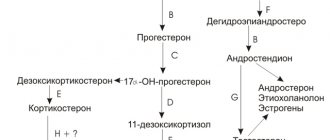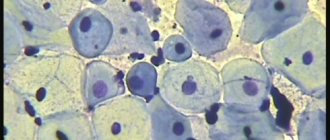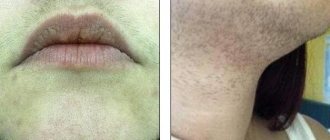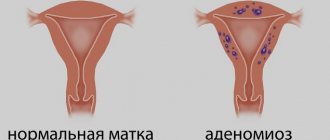Hormones not only regulate the normal functioning of the body as a whole, they also influence the formation of secondary sexual characteristics and a woman’s ability to conceive and bear a child. Estradiol, the norm of which in women differs by age, is one of the most important hormones affecting reproductive functions. However, monitoring its level is important not only for those who are planning to have children in the near future - deviations from the normal level can indicate serious health problems.
Test for estradiol
General information about the hormone
Estrogens are a group of hormones that are produced in the body of the fair sex in greater quantities than in men, which is why they are called female. The youth and attractiveness of a woman, her mood, well-being and the opportunity to become a mother depend on them.
https://youtu.be/2FVKRnZsZh8
Estradiol is a prominent representative of this group. In different phases of the menstrual cycle, its level can change, thereby affecting the body. Excessive deviations entail a malfunction in the functioning of various organs. Such disorders can be detected through a blood test and restored with medical therapy.
In the first half of the female cycle, follicles mature in the ovaries. In the largest of them, along with other estrogens, estradiol is produced, a biologically active substance. Estrogens reach their maximum at the time of ovulation, when the egg leaves the membrane of the dominant follicle.
The second phase of the cycle is characterized by the formation of a corpus luteum at the site of the released egg, which produces progesterone, necessary for the fertilization process.
At this stage, the level of the main hormone decreases.
If pregnancy does not occur, the lining of the uterus, designed to secure the fertilized egg, comes out through the vagina in the form of menstruation.
3-5 days after the start of menstruation, the entire cycle repeats again.
Causes and symptoms of decreased estradiol levels
Low estradiol in women manifests itself in specific symptoms and indicates the presence of certain pathologies.
The female body is a very delicate “mechanism”, the work of which can be disrupted by a host of factors, therefore, if any oddities, symptoms or signs appear, you should immediately consult a doctor
The reasons for the decrease in hormones are as follows:
- a sharp decrease in body weight, which is usually associated with strict diets. Weight loss affects the condition of all organs, including the functioning of the brain, pituitary gland and ovaries. These unfavorable factors, reducing the content of estradiol, contribute to the cessation of menstruation and a general deterioration in well-being. This happens with a sharp loss of 5-18% of body weight;
- severe stress that provokes hormonal imbalances. Under such conditions, the ovaries stop producing estrogens, the menstrual cycle is disrupted and, as a result, the ability to conceive decreases;
- genetic disorders in which the chromosomes that determine the structure of a woman’s genital organs are grouped incorrectly, provoking the development of dangerous syndromes;
- dysfunction of the pituitary gland under the influence of infectious diseases, with the development of tumors. Under such conditions, the production of all hormones, not only estradiol, decreases;
- dysfunction of the ovaries caused by birth defects or autoimmune diseases;
- taking contraceptives containing estradiol. Such drugs suppress the production of natural hormones in the body;
- inflammatory diseases of the reproductive system;
- alcohol abuse, smoking;
- refusal of meat.
Reduced estradiol is expressed in specific symptoms:
- absence of menstruation for a long time. If menstruation is present, severe pain is noted;
- weight loss;
- inability to get pregnant;
- changes in the condition of the skin, the appearance of rashes and irritations;
- increased sweating;
- severe acne on the skin of the face;
- feeling of dryness and itching in the vagina;
- regular headaches;
- changes in blood pressure;
- decreased libido.
Note! If estradiol is low, the specialist recommends that the woman take medications that contain this hormone in order to compensate for the deficiency.
Functions and norm of estradiol
Estradiol is directly related to the formation of female sexual characteristics that make a woman a woman:
- deposition of adipose tissue according to the female type (hips, chest) and waist formation;
- proper development of the vagina, ovaries and fallopian tubes;
- development of the milk ducts of the breast;
- pigmentation of the genitals and nipples;
- female voice;
- formation of the menstrual cycle.
This hormone has a direct bearing on the appearance and mood of a woman, the ability to conceive and give birth to a baby, and also affects the functioning of the cardiovascular system.
What else is estradiol responsible for in women:
- formation of secondary sexual characteristics;
- health of skin and hair;
- metabolic processes in the body;
- support for a positive emotional state and libido;
- affects changes in voice timbre during puberty;
- maintains healthy bone tissue;
- responsible for the utilization of “bad” cholesterol and the production of “good” cholesterol;
- has a preventive effect against thrombosis;
- normal menstrual cycle;
- preparing the uterus for conception and gestation.
The concentration of the hormone in the blood depends on the phases of the menstrual cycle, as well as on the time of day: from 15.00 to 18.00 estradiol is at its peak.
In a newborn girl, this substance is practically absent; it begins to be produced from 4 to 6 years of age and reaches high levels by adolescence.
A pregnant woman has levels increased several times. It will return to normal around the fifth day after birth. With the onset of menopause, estradiol decreases sharply and a sharp aging of the female body occurs.
How to take the test correctly
Since the concentration of sex hormones in the blood of women is constantly changing, tests must be taken at a certain time, when the results are more accurate. Estradiol, the norm of which also varies among women, is given on the 3rd day of the menstrual cycle. However, this is not all; in order for the analysis results to be as accurate as possible, you must follow certain rules:
- as already mentioned, blood can be donated for estradiol no earlier than the 3rd day and no later than the 5th day of the cycle;
- if a repeat study is required, it is carried out on day 21 of the cycle;
- a few days before the test, you should not smoke or drink alcohol;
- two days before the procedure, you need to avoid any physical activity, including sex;
- for three days before blood sampling, you need to eat right and not overeat, especially for excessively fatty foods, fried, spicy and salty foods;
- Blood must be donated in the morning before 11 o'clock on an empty stomach, you can only drink water.
Signs and causes of hormone deficiency
A reduced level of estradiol can and should be corrected, since its deficiency significantly affects the well-being and appearance of the fairer sex in the form of the following signs:
- decreased libido;
- dry skin and acne;
- increased fatigue, drowsiness, depression;
- emotional instability, nervousness and hysteria;
- poor cold tolerance;
- cold hands and feet;
- tides;
- severe premenstrual syndrome, abdominal and chest pain.
A more complex course of symptoms is expressed in excessive hair growth on the chest, face and other parts of the body.
A soft female voice takes on a masculine tone.
Menstruation comes either with delays or stops coming at all.
There is no ovulation, and pregnancy becomes impossible.
Frequent cases of thrush and vaginal dryness are also signs of low levels of this chemical.
In girls, puberty is delayed due to this disease.
The reasons for the decrease in estradiol function can be very diverse.
The most common of them are:
- Genetic characteristics, expressed in the underdevelopment of the female body: the girl’s height remains low, her breasts do not grow, the skin does not grow hairy, the body develops inharmoniously. In such cases, hormonal therapy is indicated to eliminate the lack of the desired substance.
- Irrational weight loss, unhealthy diet, which leads to sudden weight loss and, as a result, reproductive dysfunction. Adipose tissue also contributes to the production of estradiol: its decrease leads to a sharp drop in hormonal levels.
- Mental overload, stress and prolonged exposure to nervous tension can also be a cause. The functioning of the ovaries and the maturation of follicles are disrupted, and ovulation does not occur. There is a disruption in the menstrual cycle: menstruation may disappear until treatment is carried out aimed at normalizing estradiol levels.
- Excessive production of prolactin suppresses the production of estradiol. It is characterized by the appearance of breast milk not associated with feeding the baby, the growth of hair on the chin and the absence of menstruation. This phenomenon occurs when a pituitary tumor appears, so in this case it is either surgically removed, or therapy is carried out with a drug that reduces prolactin levels and restores estradiol function.
- Disruption of the pituitary gland due to radiation therapy or a previous infectious disease. The cessation of blood supply to this part of the brain leads to hormonal imbalance. With this development of the situation, the breasts become smaller, hair loss is observed on the head, pubic hair in the armpits. Menstruation stops.
- Early menopause before the age of 40 is a genetically determined phenomenon. Pregnancy and childbirth become impossible; a woman can conceive a child only through artificial insemination together with hormonal therapy.
- Excessive use of drugs that suppress ovulation or contraceptives.
Smoking and excessive consumption of alcoholic beverages can also suppress the production of estradiol.
As a result, toxins negatively affect the body, disrupting the functioning of the endocrine system and brain.
What should be the normal estradiol levels in women?
The level of the hormone estradiol in women depends on several important factors:
- age category;
- lifestyle;
- physiological characteristics of the body;
- MC phases.
In addition, there are separate indicators of the norm of estradiol in the blood of women during pregnancy. At this time, the hormone level is constantly monitored, since any deviations can lead to serious complications for both the mother and the fetus.
Estradiol in adolescence
In teenage girls, the optimal values of this hormone are considered to be between 22 and 30 pg/ml of blood. The level of the substance increases significantly by the age of 11, and it is thanks to this that the first sexual characteristics begin to appear. At this time, the process of puberty in girls begins, the first signal of which is the onset of menarche - the first menstruation.
Standards for MC phases
The rate of estradiol e2 in women, as noted earlier, varies depending on the period of the menstrual cycle.
- For the follicular phase, indicators from 57 to 227 pg/ml are considered characteristic.
- During the period of ovulation, a real “explosion” of this hormone occurs. Its values start at 127 and can reach a maximum of 466 pg/ml.
- The normal level of estradiol in women during the luteal phase should not be lower than 77 and higher than 227 pg/ml.
These indicators are generally accepted for all non-pregnant women of childbearing age. After the decline of reproductive function, the content of biological substances in the blood of representatives of the fairer sex will be somewhat different.
Age norms of estradiol
The norm of estradiol in women by age (in units of pg/ml blood) is written in the table:
| Age limits | Normal limits (pg/ml) |
| Newborn girls up to 1 year | 0 |
| Girls aged 2-3 years | Range 0-22 |
| Girls aged 4-6 years | No more than 22 |
| Teenage girls 7-14 years old | Within 22 – 30 |
| Girls over 14 years old | 57 – 480 |
| Normal levels of the hormone estradiol in menopausal women | 18 – 85 |
Important! To assess the functioning of the reproductive system, the ratio of estradiol to testosterone is assessed. Normally, it should be 10 to 1, but in some clinics the optimal ratio is 7 to 1. The highest indicator indicates estradiol, the lower - testosterone.
Estradiol during menopause
The table above indicates that the norm of the hormone estradiol in women during menopause ranges from 18 to 85 pg/ml. Reducing its concentration is a physiological process, but by no means safe. Read the link for the causes and symptoms of low estradiol in women
The fact is that a decrease in one of the main female sex hormones leads to the development of serious pathological processes in women during menopause. The most common disease is osteoporosis, in which bone tissue is affected (weakened, thinned). For this reason, women often experience fractures, sprains, dislocations and subluxations of joints.
In this case, there is only one way out - see a doctor and, if necessary, undergo a course of hormone replacement therapy. It will last until the hormone levels are brought back to normal.
Indicators in pregnant women
The norm of estradiol in women during pregnancy is calculated depending on the trimester.
- In the first 3 months, estradiol test values in pregnant women should not be lower than 210 or higher than 6300 pcs/ml.
- In the second trimester, the hormone level increases and can range from 800 to 19,000 pcs/ml.
- In the last 3 months of pregnancy, the concentration of biological substances reaches its peak. At this time, indicators can fluctuate from 11,800 to 37,000 pcs/ml.
Important! A lack or excess of estradiol in women during pregnancy can lead to the death or fading of the fetus, early miscarriage or premature onset of labor! That is why it is very important to monitor the level of this hormone throughout pregnancy.
Estradiol by MC days
Estradiol levels in women by day of the cycle play an important role. Even if the test results look suspicious to the patient herself, it is categorically unacceptable to look for reasons without consulting a doctor, and even more so to begin treatment.
The norm of estradiol on day 3 of the cycle is approximately 20 pg/ml. Why approximately? Because, as mentioned earlier, these indicators depend on the physiological characteristics of the patient’s body. Each woman's menstrual cycle is different, so fluctuations in indicators may be acceptable.
The norm of estradiol on the 5th day of the cycle is 0.08 - 1.1 nmol/l of blood. In order not to worry about the correctness of the data, the analysis must be taken on time - on the 5-6th day of the MC.
Reasons for the high level of content
An increase in this hormone is considered normal only during pregnancy; in all other cases, this phenomenon is accepted as a pathology.
Signs of excess are as follows:
- dry skin and brittle hair;
- irritability and fatigue;
- pain in the chest;
- disruption of the gastrointestinal tract;
- uterine bleeding;
- excess weight.
In little girls, this pattern leads to early puberty.
Adult women suffer from depressive disorders, anemia, and ovarian and breast tumors.
Sometimes the cause of high levels of the hormone can be excess weight gained as a result of poor nutrition, dysfunction of the liver or thyroid gland. Estrogen-containing medications and their long-term use also cause harm.
The presence of tumors in the body that provoke the production of estradiol and ovarian cysts are also causes of excess. The high content of male sex hormones in the female body, from which estradiol is produced, leads to levels above normal. In this case, the figure becomes masculine, menstruation disappears, hair falls out on the head, but grows throughout the body.
How to bring estradiol levels back to normal?
There are only two ways to do this - medication and “natural”. Treatment with medications is carried out only as prescribed by a doctor after studying the results of the analysis and diagnosis of the disease. What is important to know:
The treatment of diseases associated with disturbances in the balance of estradiol is carried out by a gynecologist-endocrinologist.
During menopause, treatment is slightly different. In this case, the patient is prescribed drugs based on estradiol, the course of treatment lasts up to three months and is carried out according to the same scheme as when taking OK.
In some cases, estrogen-based drugs may be prescribed. They are available in different forms from ointments and suppositories to tablets. The choice of the form of the drug is at the discretion of the attending physician.
If the ovaries have been removed, medications are prescribed to regulate hormonal levels, in particular the content of estrogens and gestagens.
Reasons for testing for estradiol
In case of delayed sexual development or low estrogen concentrations, a course of estradiol is required, lasting 6 months. The drug is taken for three weeks in a row, then a week break is taken and everything is repeated again.
Surgical intervention is required in extreme cases, when diagnostics showed the presence of oncology. If the deviation from the norm is small and is not caused by specific diseases, you can restore the balance by changing your habits and diet:
- Eat more foods high in phytoestrogens. These are all legumes, nuts, seeds, milk and meat.
- You should not indulge in strict diets or exclude fats and carbohydrates from your diet. This will not only be of no benefit, but will also seriously ruin your health.
- Active sexual life provokes the production of estradiol.
- Sports and moderate physical activity also help increase the amount of estradiol in the blood.
Preparations with Estradiol
If, on the contrary, there is a need for a slight decrease in estradiol levels, you should reconsider your diet and household habits. Quit cigarettes and alcohol, and if necessary, lose weight. It would be a good idea to check the condition of the gastrointestinal tract and, if there are problems, eliminate them.
Reduced estradiol
Taking birth control and chemotherapy drugs is one of the main causes of low hormone levels. This reaction is observed when using the following medications:
- Nafarelin.
- Pravastatin.
- Dexamethasone.
- Danazol.
- Mifepristone.
- Cimetidine.
Low estradiol levels can be the result of a high-carbohydrate or low-fat diet, vegetarianism, or alcohol abuse. A decrease in the hormone in women is also observed during menopause.
Important! Low estradiol levels may be a sign of pathology. This symptom indicates the presence of polycystic ovary syndrome or the presence of inflammatory diseases (most often chronic) in the organs responsible for sexual reproduction.
Symptoms of low estradiol levels:
- frequent stomach upset;
- feeling of coldness in the hands and feet;
- dry skin;
- regular fatigue;
- acne on the face;
- the appearance of hair on the body, face;
- baldness;
- swelling;
- insomnia or, conversely, frequent drowsiness;
- disruption of the menstrual cycle;
- lack of sexual desire;
- anovulatory cycle;
- infertility;
- pressure surges;
- soreness of the mammary glands;
- irritability.
A referral for testing is issued by a gynecologist or endocrinologist. To increase the amount of estradiol, substitutes for hormonal drugs are prescribed: Estrofem, Proginova, Estradiol, Estraderm TTS 25.
Functions of estradiol
One of the main roles of the hormone is to create favorable conditions for fertilization. It is also needed for:
- Controlling blood cholesterol levels.
- Stimulation of myocardial contractile activity.
- Increasing the tone and improving the functioning of smooth muscle fibers of the intestinal wall and bladder.
- Regular contraction and relaxation of skeletal muscles.
- Improving the condition of vascular walls.
- Supports body shape and weight.
- Smooth muscles.
- Increases endurance.
- Body elasticity.
The presence of normal levels of estradiol contributes to the emergence of positive emotions, which helps to feel calmer in stressful situations. The hormone also affects the maintenance of bone strength.
Estradiol and testosterone
When assessing women's health and reproductive function, experts pay attention to the ratio of estradiol and testosterone in the body. The optimal ratio is 10:1, reduction is allowed to a ratio of 7:1. If the level of estradiol is 5 or more times less than testosterone, then experts diagnose hyperandrogenemia. Symptoms of the disease:
- cycle failure;
- changing the sound of the voice (changing timbre from high to low);
- acne;
- the appearance of excess body weight for no reason.
If the level of estradiol is 12 or more times higher than testosterone, then this condition is called hypoandrogenism. The disease has the same symptoms that occur before the onset of menstruation (irritability, mood swings, etc.). Heavy bleeding also occurs at the beginning and middle of the cycle.
Important! The consequence of hyperandrogenism is the occurrence of diabetes mellitus, hypoandrogenism is the appearance of tumors of the ovaries and uterus.
Increased estradiol: what it means and how it manifests itself
Obesity, problems with the thyroid gland, liver - all this and several other factors lead to an increase in estradiol.
Increased estradiol in women is caused by several factors, including:
- obesity. In the presence of a significant fat layer, in which under normal conditions the complex process of converting male sex hormones into female ones occurs, changes occur. If estrogen levels increase, this can lead to tumor changes in the ovaries, uterus, and mammary glands;
- increased levels of androgens - male sex hormones - in a woman’s blood, which is associated with dysfunction of the thyroid gland and high levels of insulin in the blood. If estradiol is elevated for this reason, a woman may develop infertility, and her figure may change to a male type;
- ovarian tumors that actively produce female sex hormones, as a result of which high estradiol is diagnosed;
- liver damage;
- taking medications - hormonal drugs containing estrogens, anabolic steroids and some others.
Elevated levels of estradiol are expressed in the following symptoms:
- unstable menstruation;
- painful sensations in the mammary glands;
- swelling of tissues;
- convulsions;
- weight gain;
- irritability, severe fatigue;
- disruption of the functioning of the gastrointestinal tract.
To learn more about estradiol, what it is and why fluctuations in its level are dangerous, you should consult a specialist. He will also tell you how to reduce the level of this hormone and bring it back to normal.
What is estradiol? How it differs from estrogen
Spatial structure of estradiol
Estradiol belongs to the sex hormones that are part of the estrogen group. Its synthesis occurs during the fermentation of testosterone, which is formed by the endocrine glands from cholesterol. The ovaries and adrenal cortex are involved in the production of estradiol. The substance is released in both sexes. Before maturation, its indicator is the same for girls and boys. After the development of the reproductive system in women, the volume of the hormone increases, but in men it does not change.
It is not correct to call estradiol and estrogen the same thing, since estrogens are a group of hormones that includes estradiol. Thus, it is more correct to call the hormone belonging to the group of estrogens, but not just estrogen.
Estradiol during pregnancy
Despite the fact that estriol plays the main role in the pregnancy body, estradiol levels are also quite important. Its deficiency can lead to spontaneous abortion. To find out what the values of this substance should be at different stages of gestation, consider the table below.
| Gestational age | Minimum norm (pg/ml) | Maximum rate (pg/ml) |
| First trimester | 2000 | |
| Second trimester | 5000 | 8000 |
| Third trimester | 12000 | 26000 |
A lack of estrogen and, in particular, estradiol in late gestation can result in serious difficulties during childbirth, so it is important to maintain its optimal values throughout the entire period of gestation. After childbirth, hormone levels gradually decrease.
Estradiol is an important hormone from the group of estrogens, which takes part in many processes occurring in the female body. If symptoms indicating a hormonal imbalance appear, you should not hesitate to visit a gynecologist or endocrinologist, since it is much easier to deal with any abnormalities when they are at the initial stage of their development.
(Visited 40 times, 1 visits today)
Elevated estradiol
An elevated estradiol level is the norm exclusively for pregnant women. In all other cases, this is considered a pathological deviation requiring immediate intervention.
An increase in estradiol is accompanied by:
- expansion of pores;
- acne;
- sudden weight gain;
- hyperactivity of the sebaceous glands;
- increased appetite;
- irregularity of the menstrual cycle;
- increased fatigue;
- the formation of edema on the body.
Digestive problems, mood swings and sleep problems may sometimes occur.
An increase in estradiol may be due to a malfunction of the ovaries, or it may be a consequence of:
- failure in the process of synthesis of thyroid hormones;
- frequent drinking;
- pathologies of the urinary system;
- disorders of pituitary functions.
Often, an increase in estradiol levels occurs against the background of hepatic cirrhosis. It is this organ that is responsible for the destruction of hormones. If liver activity is impaired, then the consequence is the accumulation of excess biologically active substances.
Estradiol and pregnancy
The production of the hormone during pregnancy occurs in the fetal place; it is secreted by the placenta. A normal level of estradiol in the body during this period contributes to the proper development of the fetus, preventing miscarriage and premature birth. A sufficient amount of estradiol strengthens the walls of the birth canal, which helps to avoid ruptures during childbirth.
Low levels of the hormone are dangerous for pregnancy - there is a high probability of miscarriage. You can increase the value with the help of medications that contain estrogen.
During IVF, the estradiol level is taken twice: before the embryo is transferred into the uterus and after. After embryo transfer, indicators are monitored regularly. Data collection is not carried out only when a woman is prescribed alternative drug therapy (drugs containing estradiol or estrogen: Estriol, Ovestin, Estradiol Valerate, Ethinyl-Estradiol, etc.).
Estradiol: description, meaning and functions of the hormone
Estradiol is a sex hormone that performs very important functions in the female body
Some female hormones are produced by the brain; they further control the production of follicle-stimulating and luteinizing hormones.
Other hormones appear in the ovaries; they form a group of steroids. This group consists of estrogen substances and progesterone. The estrogen series is represented by three estrogens. The strength of their influence on the female body is not the same. The most potent sex hormone is estradiol.
Estradiol is responsible for performing the following tasks in a woman’s body:
- manifestation of secondary gender characteristics (higher voice than men, rounded hip line, etc.)
- control of the menstrual cycle
- egg formation
- growth in the size of the uterus as the fetus enlarges during pregnancy
- creation of a layer of subcutaneous tissue
- maintaining normal blood clotting
- breast development
- establishment and maturation of the reproductive system
- eliminating excess cholesterol
- stimulating bone turnover
- strengthening the heart muscles
- maintaining normal blood pressure
- responsible for sound, restful sleep
All of the above allows us to call estradiol one of the main sex hormones in a woman’s body. After all, it is he who is not only responsible for a woman’s attractiveness, but also controls her health. An imbalance of estradiol in the female body leads to the development of certain diseases.









